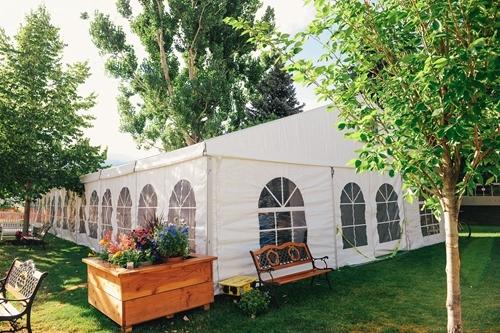· Material Characteristics: High-strength aluminum alloy (such as 6061/T6) is used, featuring light weight, corrosion resistance, and impact resistance.
· Normal Service Life:
· Indoor or Dry Environment: 20-30+ years (50 years with proper maintenance).
· Outdoor Open Environment: 15-25 years (affected by UV rays, humidity, salt spray, etc.).
· Coastal or High-Corrosion Areas: 10-15 years (requires additional anti-corrosion treatment).
· Influencing Factors:
· Surface treatment processes (e.g., anodizing, powder coating): An anodized film thickness of ≥10μm can extend corrosion resistance.
· Structural design rationality (e.g., stress concentration points, drainage systems).
· Common Materials: PVC-coated fabric, PVDF membrane, PTFE membrane (glass fiber + polytetrafluoroethylene).
· Service Life:
Material | Indoor Environment | Outdoor Environment | High UV/Harsh Climate |
PVC Tent Fabric | 8-12 years | 5-8 years | 3-5 years (prone to aging and embrittlement) |
PVDF Membrane | 10-15 years | 8-12 years | 5-8 years |
PTFE Membrane | 20+ years | 15-20 years | 10-15 years |
·
· Characteristic Differences:
· PVC tent fabric: Low cost but poor weather resistance; requires regular cleaning to prevent mildew.
· PTFE membrane: Strong self-cleaning and anti-aging properties, but high cost; suitable for high-end scenarios.
· Materials: Stainless steel (e.g., 304/316), high-strength steel (galvanized treatment).
· Service Life:
· Stainless steel fittings: 15-20 years (outdoor environment), with excellent corrosion resistance.
· Galvanized steel fittings: 8-12 years (prone to rust; regular inspection of the anti-corrosion layer is required).
· Key Components: Wear-prone parts such as bolts, fasteners, and pulleys require regular lubrication or replacement.
· Anchors: Steel ground stakes or concrete foundations, with a service life consistent with the building (≥50 years); require anti-loosening and anti-rust measures.
· Counterweights: Concrete blocks or metal counterweights have no clear service life limit but need protection from physical damage.
· Wind and Earthquake Resistance: Design the structure according to local climate conditions (e.g., reinforce frame connections for 10-level wind resistance).
· Anti-Corrosion Treatment: Use thickened anodized or stainless steel frames in coastal areas, and select salt-spray-resistant tent fabrics.
· Frame Inspection: Clean the aluminum alloy surface annually, and check for cracks in welds and loose bolts.
· Tent Fabric Maintenance:
· Clean drainage grooves before the rainy season to prevent water accumulation.
· Clean the tent fabric with a neutral detergent every 2-3 years to remove dust and chemical contaminants.
· Fitting Replacement: Inspect galvanized fittings for corrosion every 5 years, and replace severely worn bolts and pulleys promptly.
· Avoid Overloading: Never stack heavy objects on the tent roof or hang equipment exceeding the design load.
· Extreme Weather Response: Remove tent fabrics or take reinforcement measures before typhoons or blizzards to reduce structural loads.
Application Scenario | Typical Service Life (Comprehensive) | Core Maintenance Requirements |
Warehousing/Temporary Exhibitions | 10-15 years | Regularly clean tent fabric; check anchor firmness |
Sports Venues/Permanent Buildings | 20-30 years | Use PTFE membranes and stainless steel fittings; professional team maintenance |
Outdoor Activities/Seasonal Setup | 5-8 years | Inspect frame wear after each setup; repair tent fabric promptly |


Hi! Welcome back.
How are you doing?

+86 17712768856
NO.1319-1 Xicheng Rood Qingyang village, Jiangyin City,Jiangsu Province,China
Subscribe today and get educated and entertained with the monthly SYXTENT email